- Finance
-
Equipment
- Beverage
- Coffee
-
Cooking
- Shop all cooking
- Bratt pans
- Char grills
- Chicken rotisseries
- Combi ovens
- Contact grills
- Convection ovens
- Conveyor toasters
- Cooktop oven combos
- Cooktops
- Deck ovens
- Fryers and oil filters
- Griddles
- Kebab machines
- Microwaves
- Pasta cookers
- Pizza ovens
- Range ovens
- Rice cookers
- Salamander grills
- Sous vide
- Speed ovens
- Tandoor ovens
- Toaster grills
- Waffle makers
- Wok burners
- Other
- Dishwashers
- Food display
- Food preparation
- Furniture
-
Refrigeration
- Shop all refrigeration
- Blast chillers
- Chest freezers
- Countertop fridges
- Display freezers
- Display fridges
- Gelato freezers
- Ice-cream machines
- Ice machines
- Pizza prep fridges
- Refrigerated drawers
- Sandwich prep fridges
- Slushie machines
- Under counter freezers
- Under counter fridges
- Upright freezers
- Upright fridges
- Other
- Stainless steel
- Hot deals
- Shop all equipment
- Customers
- Become a Partner
- About Us
Share
Best Commercial Coffee Grinders: Buyer’s Guide
article
What’s inside this buyer’s guide
- Introduction
- Types of commercial coffee grinders
- Styles of commercial coffee grinders
- Things to consider before purchase
- Best makes of commercial coffee grinders
- Used commercial coffee grinders — worth considering?
- Frequently asked questions
- Commercial coffee grinder glossary
- Keep your cash; use ours!
Every coffee shop has its soul, and it often lies in the hum of its commercial coffee grinder.
It's more than a machine; it's a bridge connecting passionate farmers and their exquisite beans to the daily ritual of countless coffee lovers.
However, every space has its unique rhythm and needs.
Be it budget constraints, spatial dimensions, brewing volume, or specific grinding nuances, selecting the right grinder is an art.
This guide aims to simplify that choice, ensuring every cup you serve feels like a masterpiece.
Types of commercial coffee grinders
Much like the diverse flavours of coffee beans, grinders, too come in a unique blend of automatic, semi-automatic, and manual – each telling its own tale in the journey from bean to cup.
We'll break down the features and benefits of each, helping you make the best choice for your needs.
Automatic coffee grinders

An automatic coffee grinder is designed to take the guesswork and manual labour out of grinding coffee beans.
At its core, it's built to deliver consistent, freshly ground coffee at the push of a button.
Instead of manually adjusting or grinding, the machine does the work for you, ensuring the same quality grind every time.
Design
These machines are tailored for busy environments.
They have a doser that pre-grinds the coffee, so it's always ready for brewing.
Many come with features like a built-in grinder and milk frother, catering to various coffee preferences.
They're flexible, too, accommodating both whole beans and pre-ground coffee.
How it works
You load the beans, press start, and the grinder uses its burr or blade mechanism to transform those beans into coffee grounds.
It's designed with efficiency in mind: the grinder will stop once the doser is full, preventing overflows.
Applications
Think of busy cafes or restaurants with a continuous demand for coffee.
The automatic replenishment means the doser is always filled.
But they're not just for high-demand spots; they fit right into specialty venues where specific grind quantities matter.
Benefits
The biggest takeaway? Convenience.
Automatic grinders deliver freshly ground coffee faster and more consistently than their manual counterparts.
This consistent grind size is crucial for optimal coffee extraction, leading to a better cup every time.
In the world of coffee, fresh always trumps pre-packaged, and these machines are champions of fresh.
Semi-automatic coffee grinders

A semi-automatic coffee grinder gives you more control and flexibility over the grinding process.
It allows you to adjust the grind size, dose, and time according to your preference and brewing method.
Unlike an automatic grinder, it requires you to manually start and stop the grinding operation.
Design
These machines are designed for coffee professionals who want to offer more variety and customisation to their customers.
They have a hopper that holds the beans, a burr or blade mechanism that grinds them, and a doser or dispenser that releases them.
Some have a timer or a scale that helps you measure the amount of coffee grounds.
How it works
You fill the hopper with beans, select the grind size, and press a button or a lever to start the grinding.
You can either use the timer or scale to determine the dose or manually stop the grinding when you have enough coffee grounds.
You can then dispense the grounds into a portafilter, a filter basket, or a container.
Applications
Think of commercial coffee shops and restaurants where you want to create different types of coffee drinks, such as espresso, cappuccino, café latte, and more.
The semi-automatic grinder lets you fine-tune your grind size and dose to suit your taste and brewing method.
You can also use it for different types of coffee beans, roasts, and blends, allowing you to showcase your coffee expertise and creativity.
Benefits
The main advantage of a semi-automatic grinder is the control and flexibility it offers.
You can experiment with different variables and find your ideal grind size and dose for each cup of coffee.
You can also enjoy the freshness and flavour of freshly ground coffee without sacrificing too much convenience.
Manual coffee grinders
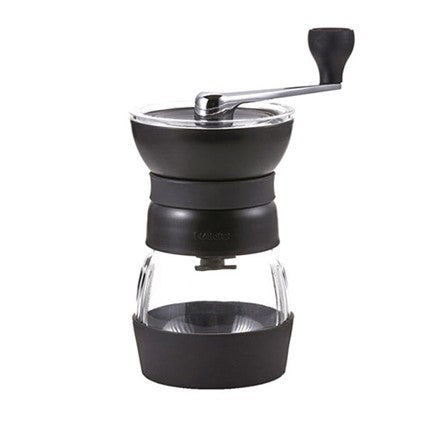
Manual commercial coffee grinders empower baristas and coffee lovers to handcraft their grinds, promising a bespoke coffee experience.
Commonly seen in coffee establishments valuing fresh, top-tier brews, these grinders have a few defining features.
Design
Boasting a minimalist and compact structure, manual grinders are made up of a bean hopper, grinding burrs, and a grounds chamber.
How it works
The burrs come into action by rotating a lever, crushing the beans consistently.
The freshly ground coffee then settles in a chamber beneath the burrs.
Applications
They aren't just about looks or mechanics; they're versatile.
Be it for a French press, espresso, or pour-over, these grinders are up for the task.
Their compact design also makes them an excellent fit for cosy corners.
Benefits
The perks of going manual?
Precision in grind size, hushed operations, cost-effectiveness, and durability.
Plus, grinding just before brewing means each cup captures the full essence and aroma of the beans.
Styles of coffee grinders
Building on our exploration of the types of commercial coffee grinders, we'll now focus on the different styles within these types.
These styles not only determine how your coffee is ground but also influence the overall flavour and quality of the resulting brew.
Burr Grinders
Burr grinders utilise two rotating surfaces, called burrs, to crush and grind coffee beans into uniform and consistent particles.
They are ideal for cafés that wish to achieve a high-quality brew, as the even grind size allows for a balanced extraction of flavour and aroma.
Burr grinders can have either flat or conical burrs, which differ in shape and performance.
Flat burr grinders
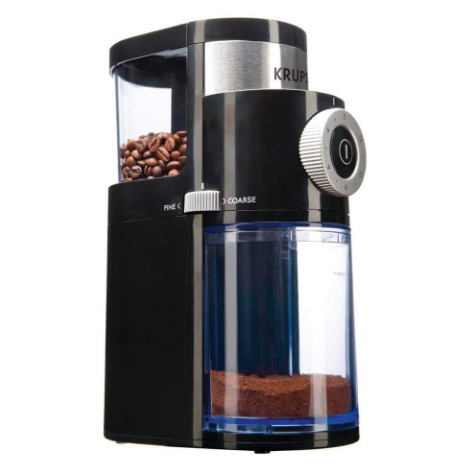
Flat burr grinders utilise two flat and parallel surfaces, called burrs, to crush and grind coffee beans into even and consistent particles.
They are suitable for espresso, as they produce a balanced extraction and a clear flavour profile.
However, they can be noisy and may retain more grounds than other types of grinders, so they need regular cleaning to prevent old coffee residues.
Conical Burr Grinders
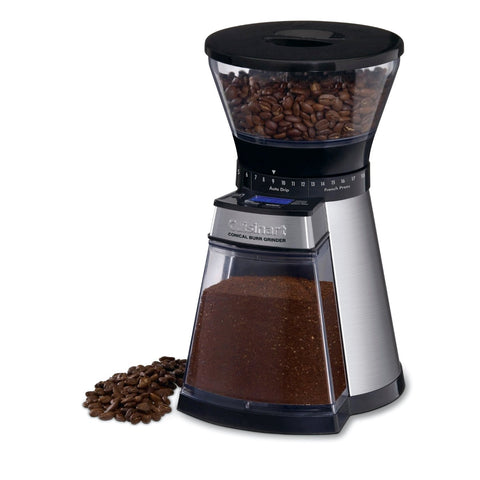
Conical burrs use a cone-shaped surface, called a burr, within an outer ring surface, also termed a burr, to crush and grind coffee beans into uniform and consistent particles.
They are popular for their adjustability and consistency, as they can produce different grind sizes and suit various brewing methods.
They are also quieter and easier to clean than other types of grinders, as they tend to clog less and have fewer grounds retention.
Blade grinders

Blade grinders are machines that use a sharp blade that spins rapidly to chop and grind coffee beans.
They are not very consistent, as they produce uneven grinds that can affect the quality of the brew.
To get a slightly better grind, you can pulse the blade rather than run it continuously.
Blade grinders are cheap and easy to use, but they are not the best choice for premium brews.
On-demand grinders
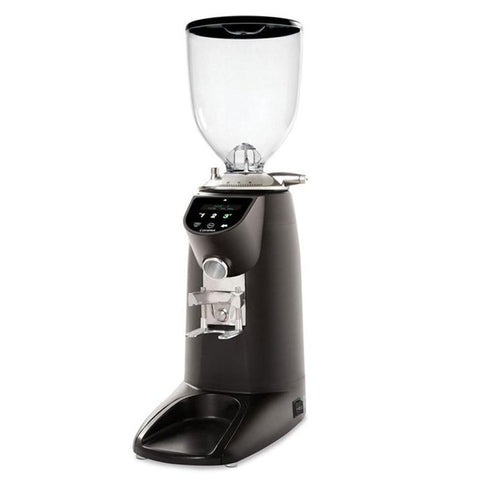
On-demand grinders are designed to precisely grind coffee beans at the moment they are needed, delivering the grounds directly into a portafilter or a bag.
These grinders prioritise freshness, thereby enhancing the flavour and aroma of the coffee.
Furthermore, they help reduce waste by grinding only the necessary amount for each cup.
On-demand grinders prove especially advantageous in cafes with a high volume of coffee orders, as they consistently deliver fresh grounds for every customer.
Stepped adjustment grinders
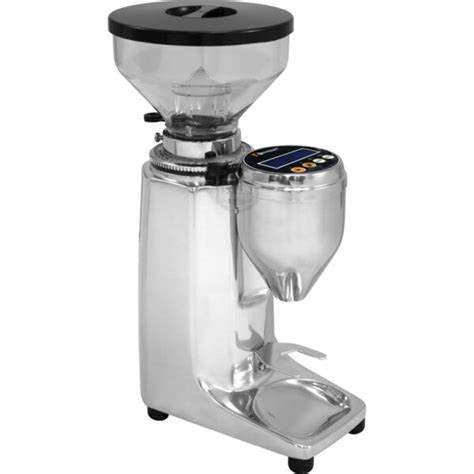
Stepped adjustment grinders are machines equipped with pre-defined and fixed grind settings, commonly referred to as "steps."
These settings are easy to switch between, but they provide limited granularity in terms of grind size adjustment.
When you make changes to the grind size, you can distinctly hear a clicking sound on these machines.
Stepped adjustment grinders are well-suited for cafes with consistent and unchanging menus, where frequent adjustments to the grind size are not required.
Additionally, they serve as an excellent choice for newcomers in the coffee industry due to their straightforward and user-friendly nature.
Step-less adjustment grinders

Step-less adjustment grinders offer the freedom to select any grind size you desire without being confined by pre-set settings.
These grinders provide meticulous control over the grind size, a crucial feature for crafting custom brew recipes and accommodating various brewing methods.
They are the favoured choice of coffee enthusiasts who seek the utmost precision and flexibility in their coffee preparation.
Step-less adjustment grinders prove to be the perfect fit for cafes striving to deliver gourmet coffee experiences or those that frequently adapt their brewing methods to cater to their customers' unique preferences.
Things to consider when buying a commercial coffee grinder
Type of coffee
Before you dive in and purchase that sleek new commercial coffee grinder, you'll need to ask yourself:
What type of coffee will I be serving?
While it might seem like a straightforward question, it's one that greatly influences the equipment you choose for your venue.
With coffee enthusiasts having a much more discerning and varied palate than ever before, you'll need to decide whether your café will be churning out high-volume coffee for the masses, or are you aiming to delve into the high-end realm of seasonal varieties and rare single origins.
And, how will they be served?
Do you need an espresso grinder? A filter grinder? Perhaps a versatile one?
Some commercial coffee grinders target specific brew methods for particular coffee types.
Therefore, having a clear understanding of your coffee origins, brewing methods, and your intended customers is crucial before making such a significant investment.
Coffee consumption
Once you've pinned down the coffee blend or origin for your customers, it's essential to gauge the volume of coffee your venture might handle weekly.
Your choice in a commercial coffee grinder will largely hinge on practicalities.
Is your spot primarily a coffee sanctuary, where every brew needs to be of premium quality? Or is coffee a delightful addition to an already diverse menu?
For busy locales shifting over 40kg of coffee weekly, a grinder's efficiency is essential. It should reignite promptly post each serving, regulate its warmth adeptly, and promise a steady grind every single time.
For more intimate venues or those championing niche brewing styles, the bells and whistles of top-tier grinders might be overkill.
Opting for a simpler machine without the high-end frills can be both cost-effective and apt for your needs.
Dosing system
Commercial coffee grinders primarily rely on two types of dosing systems:
Time-based system
In this system, the grinder dispenses coffee based on a predetermined duration.
Once you've adjusted the settings to get the ideal morning shot, you can simply set the timer and let the machine handle the rest. It's a straightforward "set and forget" approach, and it's why many commercial establishments prefer this method.
However, there are a few challenges:
Factors that can affect grind consistency include:
- The density of the coffee beans.
- Ambient humidity.
- The volume of beans remaining in the hopper.
While the discrepancies introduced by these factors might be subtle, for those who prioritise absolute precision, a shift towards gravimetric grinders could be beneficial.
Gravimetric system
Gravimetric grinders function by weighing the ground coffee directly as it is dispensed into the portafilter.
Similar to timed systems, once you've selected your optimal weight, minor adjustments can be made throughout the day.
The primary advantage of a gravimetric system is its precision.
Grinding by weight ensures a more consistent grind size, which is vital when aiming for a specific brew ratio.
This method guarantees that your coffee basket contains a consistent amount every time, undeterred by bean density variations, external weather conditions, or the quantity of beans left in your hopper.
Aesthetics
Let's have a chat about aesthetics. Why? Because just as that first sip matters, so does the first visual impression! Here are some factors to consider when choosing a commercial coffee grinder based on the visual appeal:
- Design: Have you thought about the vibe you're setting? A futuristic, shiny grinder screams modernity, while a classic Italian piece might transport your guests straight to the streets of Rome. What story do you want your grinder to tell?
- Size and shape: Take a quick scan of your space. Can you envision a petite, sleek grinder nestled in a corner? Or perhaps, a majestic one holding its own amidst rustic décor? Size does matter, and so does shape!
- Colour and material: Let's talk personality. Fancy a clean, stainless steel look that means business? Or are you drawn to a grinder adorned with warm wood accents that whisper of cosy coffee nooks? Which one feels like you?
- Brand and model: Are you one for brand badges? Some coffee grinder brands are like celebrities in the caffeine world. Flaunting a renowned brand might just make your coffee corner the talk of the town!
Ease of use
Your coffee grinder should be more than just a machine; it should seamlessly integrate into your daily operations, making every cup of coffee an artful experience.
Here are some key aspects of ease of use to prioritise when choosing a commercial coffee grinder:
User interface
Opt for a grinder equipped with a user-friendly interface. Features like a digital display, timer, scale, or intuitive dial should be present.
The ability to easily and accurately adjust grind size, dose, and timing is crucial. Quick access to the grinder's status and settings at a glance is also beneficial.
Hopper and doser
Ensure that the grinder offers a spacious and transparent hopper and doser, capable of accommodating the coffee bean and ground coffee volume required for your business.
Burr or blade mechanism
Select a grinder with a durable and efficient burr or blade mechanism capable of consistently producing high-quality grinds.
Accessibility for regular cleaning and maintenance of this mechanism should be straightforward.
Take into account the noise level and heat generation of the grinder, as these factors can impact both performance and coffee quality.
Safety features
Prioritise a grinder with built-in safety features to prevent accidents and injuries. Features like automatic shut-off, overload protection, lock-out switches, or tamper mechanisms contribute to a safer operating environment.
Always adhere to the manufacturer's guidelines and recommendations to use and maintain the grinder safely.
Ease of cleaning
Ensuring your coffee shop or restaurant operates at its best requires careful consideration of every facet of your equipment.
Your grinder should not only deliver exceptional coffee but also uphold the highest standards of hygiene and maintenance.
Here are key aspects of ease of cleaning that should guide your choice:
Hopper and doser
Don’t overlook details like removable and washable hopper and doser.
The ability to disassemble these components facilitates thorough and regular cleaning.
Additionally, assess the design of the hopper lid, portafilter holder, and knock box to ensure they are easy to clean and function effectively.
Burr or blade mechanism
Opt for a grinder that provides straightforward access to and removal of the burr or blade mechanism.
This feature simplifies the cleaning process, allowing you to maintain it properly.
Take into account noise levels and heat generation, as these factors can impact both the grinder's performance and the quality of your coffee.
Exterior and interior materials
Prioritise a grinder constructed from smooth and durable materials, such as stainless steel, plastic, or ceramic, for both the exterior and interior parts.
These surfaces should be easy to wipe clean with a damp cloth or a soft brush, effectively removing dust and dirt.
Avoid using harsh chemicals or abrasive materials that could harm the grinder.
Manufacturer's guidance
Seek a grinder that comes with clear, detailed instructions, and recommendations for cleaning and maintenance.
Carefully follow these guidelines on a regular basis to ensure optimal performance and longevity.
Should you encounter any issues or questions regarding cleaning and upkeep, don't hesitate to reach out to the manufacturer's customer service for assistance.
Best makes of commercial coffee grinders
Fiorenzato

Founded in 1936 by Pietro Fiorenzato, Fiorenzato has become a hallmark of Italian excellence in the realm of coffee grinding.
With a legacy spanning over eight decades, the brand has consistently been at the vanguard of designing and manufacturing professional grinders and grinder-weighers.
Crafted with precision from painted die-cast metal, Fiorenzato grinders are celebrated for their micrometric and continuous grinding regulation, ensuring each coffee bean is ground to perfection.
Among their esteemed line-up, the semi-automatic F4 E and F83 E45 models are particularly favoured by high-volume coffee shops. The F4 E, despite its compact design, boasts 58-mm flat burrs and is energised by a 250-Watt motor, making it an ideal choice for establishments with space constraints but unwilling to compromise on grind quality.
In contrast, the F83 E45, equipped with larger 83-mm flat burrs and a potent 650-Watt motor, promises meticulous coffee grinding, setting the foundation for unparalleled brews.
Both these models underscore Fiorenzato's commitment to delivering freshly ground coffee with every use, encapsulating the essence of Milanese coffee tradition.
Shop Fiorenzato commercial coffee grinders now.
Mazzer
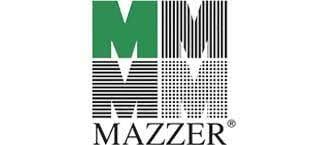
Mazzer, a family-owned company based in the countryside near Venice, Italy, was established as a precision mechanic workshop between the two World Wars.
It wasn’t until 1948 that Luigi Mazzer began producing professional-grade coffee grinders and burrs, marking the company’s transition to "Mazzer".
Today, Mazzer is a favoured brand in New Zealand, known for its unmatched durability and precision in bustling cafés and elegant hotels.
Two of their standout models include the Mini A and Super Jolly. The Mini A is a compact commercial coffee grinder with a heavy-duty die-cast aluminium body and step-less control, making it ideal for small cafes and low-volume shops.
The Super Jolly is an electronic grinder-doser suitable for medium consumption. It offers on-demand grinding with electronic dose adjustment.
With Mazzer, consistency isn’t just a feature; it’s a guarantee.
Shop Mazzer commercial coffee grinders now.
Macap

Macap, an acronym for Macina Caffè Petiziol, is a renowned company that specialises in coffee equipment. The company was established in 1930 by its founder, Ottorino Petiziol, who opened his mechanical workshop in the Venetian hinterland. The company took its current name at the end of the 1980s. Today, it is led by its third generation.
Macap has been refining its craft for decades and is known for its high-quality, durable, and long-lasting espresso coffee grinders. These grinders are designed with both functionality and aesthetics in mind, making them suitable for professional use.
Among their impressive line-up, the M2M emerges as a favourite for intimate settings.
Its compact design, boasting 50mm flat burrs powered by a 250-Watt motor, coupled with its manual step adjustment and a sturdy metal fork, makes it an asset for smaller ventures.
Meanwhile, the MI20 Touch adds a dash of modernity with its 58mm flat burrs, 300-Watt prowess, and an avant-garde 3.5” touch screen - a testament to Macap's in-house innovation.
With these gems, every grind promises fresh, consistent coffee magic.
Shop Macap commercial coffee grinders now.
Compak

With a reputation for crafting outstanding coffee grinders, Compak has garnered a robust following in New Zealand's bustling café landscape.
Its hallmark? Precision combined with rugged durability. From cafés to elite hotels, Compak grinders are the secret behind countless impeccable brews.
Among their prestigious line, the K10 Conic stands tall. A traditional grinder equipped with 68mm conical burrs, it boasts a formidable motor adept at handling high-demand situations without compromising the coffee's integrity, all thanks to its cold grinding mechanism. Its sleek design, complemented by an intuitive grind adjustment collar, marries function with flair.
Not to be outdone, the E10 Master Conic OD takes coffee grinding to new technological heights. This on-demand marvel, armed with 68mm conical burrs, sports a futuristic touch screen and dual fans. Its micrometric grind setting collar ensures that baristas always have the precision they need to craft the perfect espresso.
With Compak, perfection is just a grind away.
Shop Compak commercial coffee grinders now.
Anfim

Anfim, a Milan-based manufacturer, has been a mainstay of traditional Italian espresso preparation since 1932.
The company is known for its love for the technical complexity and artistry of espresso preparation.
Anfim’s product portfolio features espresso grinders for a range of performance requirements, from modest to fast-paced daily workloads.
They meet the most specific demands of quality-conscious baristas with uncomplicated functionality and aroma-saving grinding
Anfim offers two top semi-automatic burr grinders for busy coffee shops — the SP II+ and the Caimano. The SP II+ has strong burrs and a powerful motor, grinding up to 6 kg of beans daily. It also has smart sensors and a cooling system for smooth operation.
The Caimano uses a slightly smaller motor but can still handle 2 kg of coffee each day. Both grinders are known for their precise Italian design and quality. Choosing either means getting a piece of Milan's coffee tradition.
Shop Anfim commercial coffee grinders now.
Used commercial coffee grinder — worth considering?
Spending thousands of dollars on a new commercial coffee grinder can put a strain on your budget and cash flow.
If you’d prefer not to invest a lot of money in a coffee grinder, a cheaper, pre-owned appliance might be the solution you’re looking for.
SilverChef’s range of ‘Certified Used’ commercial equipment is mostly ex-rental equipment sourced from businesses we know and trust.
The equipment is typically less than two-and-a-half years old, has been fully refurbished by us, and is backed by a three-month parts-and-labour warranty.
Considering the effective, or useful, life of a coffee grinder is much longer, you can be sure our Certified Used commercial coffee grinders have plenty of life left in it.
You can either buy or finance the ‘Certified Used’ (and clearance) equipment on our website. (We’re one of the few financiers, if not the only one, in New Zealand that funds second-hand commercial kitchen equipment).
Read more about ‘Certified Used’ equipment
Frequently asked questions
How do commercial coffee grinders work?
Commercial coffee grinders finely process coffee beans for brewing.
There are two primary mechanisms:
- Burr grinders: Preferred for precision, they crush beans between two rotating surfaces. They come in flat and conical shapes. The flat version gives a uniform grind, while the conical offers varied textures.
- Blade grinders: Using a spinning blade, they chop beans; consistency depends on duration.
Driven by robust motors, commercial grinders operate without overheating, preserving bean flavour.
Beans are stored in an upper hopper, then ground and collected below.
The machine's settings adjust the grind size, catering to different coffee types.
How to clean a commercial coffee grinder?
To clean a commercial coffee grinder, follow these steps:
- Unplug the grinder: Always prioritise safety. Disconnect the grinder from the power source.
- Empty and clean the hopper: Before proceeding, make sure the hopper is devoid of beans. Detach the hopper, then wash it alongside its lid and any sealing gaskets using warm soapy water. After rinsing, pat them dry with a soft cloth.
- Brush the burrs: With a manufacturer-recommended brush or a soft one, meticulously clean the grinder's burrs, ensuring no coffee residues remain.
- Clear remaining residues: For a thorough clean-up, vacuum inside the grinder or wipe it with a lint-free cloth, taking care not to disrupt its internal parts.
- Let the grinder dry: Avoid grinding while components are still damp. Wipe down with a cloth and let it air dry before its next use.
Regular maintenance ensures your grinder operates efficiently and your coffee remains fresh and flavourful.
How long does a commercial coffee grinder last?
A commercial coffee grinder's lifespan varies based on factors like type, material, usage, and maintenance.
Burr grinders, especially those with stainless steel or ceramic components, can last 5-7 years or even up to 30 years with proper care.
However, frequent use and lack of cleaning reduce its longevity. While grinders can last 5-10 years, their burrs or blades might need replacement after grinding about 454 Kg of coffee.
Commercial coffee grinder glossary
Hopper
The container that holds your unground coffee beans, directly connected to your commercial coffee grinder.
Doser
A compartment where the ground coffee is stored. Using a lever, it releases fixed portions of coffee for your chosen brewing method.
Burrs
Textured surfaces used for grinding coffee beans with precision. They achieve better consistency than bladed grinders, especially for coarser grinds like those in French press or pour-over coffees.
Flat burr
A disk-shaped grinder that yields highly consistent coffee particles.
Conical burr
A cone-shaped grinder effective for grinding coffee, though slightly less consistent than a flat burr.
Volume
A term describing the quantity of coffee you sell weekly. A high-volume café would sell over 40 kilograms weekly, with roughly 60-70 servings derived from each kilo.
Automatic
Grinds coffee directly into the doser, making it immediately available. Ideal for busy venues.
Semi-automatic
Grinds only when the barista positions the container or portafilter and activates the machine. Suited for quieter or specialty venues.
Stepped grind adjustment
Distinct settings on a grinder's adjustment mechanism without intermediate options.
Stepless grind adjustment
A mechanism without pre-set grind sizes, offering the user more nuanced control and the ability to make extremely fine adjustments.
Retention
Refers to the coffee left in the grinder post-grinding. Finer grinds, such as those for espresso, generally lead to higher retention.
Uniformity
The consistency of the coffee grind. Superior uniformity ensures coffee grounds are near-identical in size. A commercial grinder that offers top-notch uniformity results in consistent, high-quality brews.
Keep your cash, use ours!
We hope this guide has helped you better understand what you need to look for in a commercial coffee grinder and how to choose the right model for your needs.
If you want to know more, you can always reach out to the SilverChef team.
Hospitality equipment can be expensive, and paying for it outright can put pressure on your business’s cash flow.
Our finance solutions allow you to get the equipment you want now and to pay for it in small, regular amounts out of the revenue it generates for you.
Rent–Try–Buy® not only helps you maintain your cash flow, it gives you unrivalled flexibility to adapt your equipment to the changing needs of your business.
You can upgrade or buy the equipment at any time or, after 12 months, return or continue renting it.
If you decide to buy the equipment, we’ll give you back 50% of the rent you paid in the first year and 25% of any rental payments thereafter — to put toward the purchase price.
